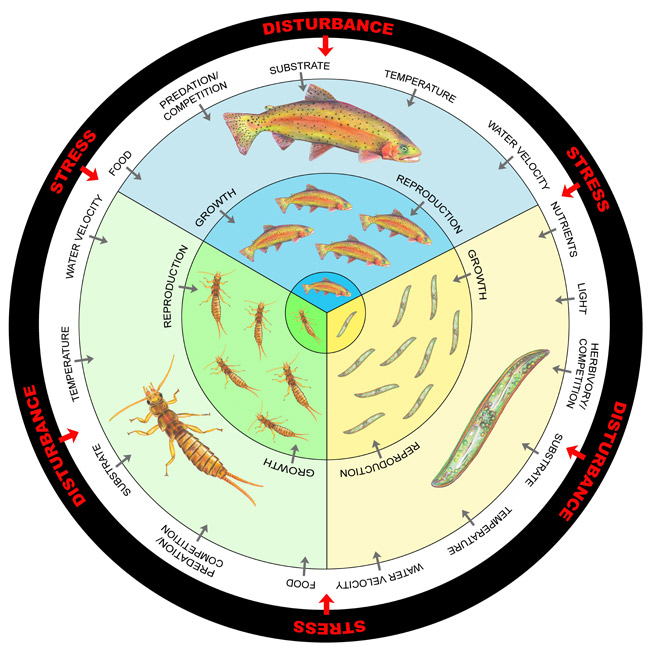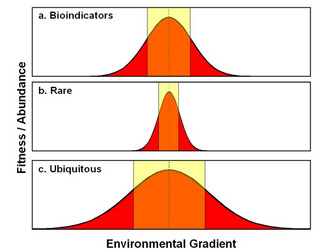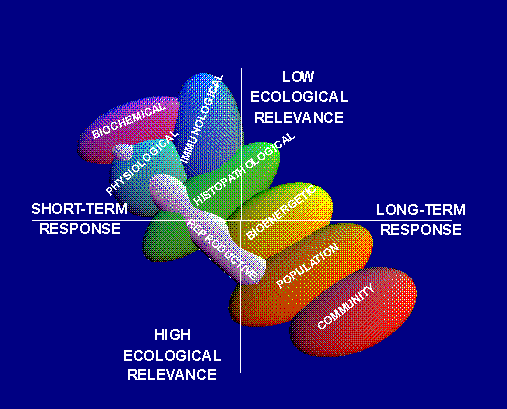Bioindicator
A bioindicator, also of indicator, pointer type or an indicator organism is a living being that responds to environmental influences with changes in its life functions or substances attaches or incorporates into the organism. These environmental influences are often caused by man. The response to specific stresses, as well as site and environmental conditions, such as moisture, light, heat, pH, nutrient conditions of soil, water or air pollution is being used in environmental monitoring and environmental monitoring.
Measurable metabolic products of bio-indicators are also referred to as biomarkers. The significance of a biological indicator is higher, the more sensitive it reacts to changing external influences. The value of the use of bio-indicators is thus saved the measurements or tests that need to be performed usually over much longer periods of time.
- 3.1 Biological Methods
- 3.2 Physico-chemical methods
System
There are sensitive or reactive bio-indicators ( response indicators). These are sensitive creatures that react quickly, selective and highly sensitive to pollutants in their habitat (eg goldfish in chemical plants which groundwater contamination highly sensitive show, which today is no longer very common method → Animal Welfare)
Then there are the accumulative bioindicators ( accumulation indicators). These are living things, mostly plants, which accumulate certain pollutants (eg, the elder as fluorine collectors ) and make as detectable without showing itself this early damage.
One can distinguish active and passive methods. In the active method bioindicators be exposed to a different environment ( exposed) to be observed therein or removed later for analysis. In passive method bioindicators be observed in their natural environment or removed for analysis from their natural environment.
R = Response indicators, A = accumulation indicators
Examples
Naturally occurring bio-indicators are inter alia
Artificially introduced bio-indicators have now also been standardized. Examples:
Use
Bioindicators have been used for about 4 decades in the control environment, such as the issuer monitoring ( kale, ryegrass), are used. Since recently, they look for nature conservation and landscape planning ( performance reviews, state analysis) as well as in conservation research use. Depending on the target and task can take over indicator functions several animal and / or plant species. Indicator species for the characterization of still and running waters are, for example, dragonflies, as they are complex demands on the habitat with respect to the structural diversity of the vegetation, the presence of various sub- habitats and their networking. They also provide an opportunity to assess by means of the detection of exuviae ( larval skins) of aquatic living dragonfly larvae, the reproductive rate or water quality.
In assessing the quality of water one uses also the found in the water Saprobien ( certain types of fungi, bacteria and protozoa ) as indicators. Different Saprobien are typical for certain levels of pollution.
Advantages and disadvantages of the biological and physico-chemical methods
Biological methods
- Enter the total of all individual components with tolerances to
- Be comprehensive accurate statements about
- Are not dependent for nationwide conclusions on computational models
- Give a sample of the long-term value of individual components of
- Indicate compliance, exceeded or fallen short of tolerance values of individual components to
- Provide information about the individual effects and the interaction of various components
- Simple, low in cost
- Work with instrumentation that can not fail
- Sensitive as they can accumulate even the smallest pollutant concentrations over a long period and thus make detectable
- May yet prove unknown toxins
- The quantification shows a low precision.
Physico-chemical methods
- Chemical- analytical methods provide accurate values for selected individual components.
- These methods return the current value of individual components ( low inertia ) with a sample.
- Long-term measurements allow the determination of exact fluctuations of the measured components.
- These methods only anecdotal to exact statements.
- Area-wide statements can only be achieved through computational models.
- Information is selective and can only provide indirect information about the individual effects or the interaction of various components.
- Analytical systems are complicated and cause ongoing maintenance costs and reagents.
- When unexpected failure of measuring time periods resulted without readings.



.jpg/51560941/286x198/emde_vol2no10_photo3_bioindicators_Full(1).jpg)






